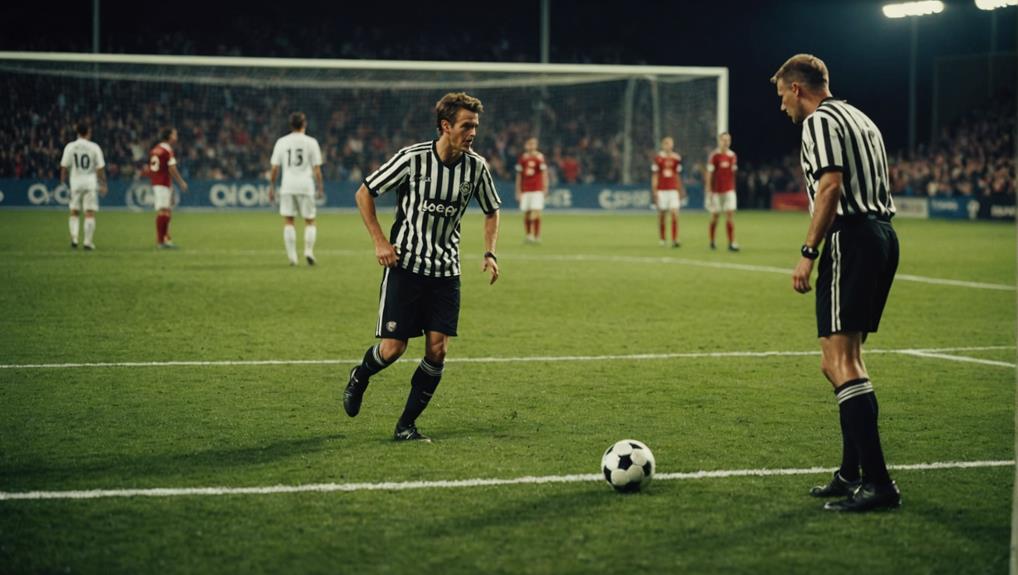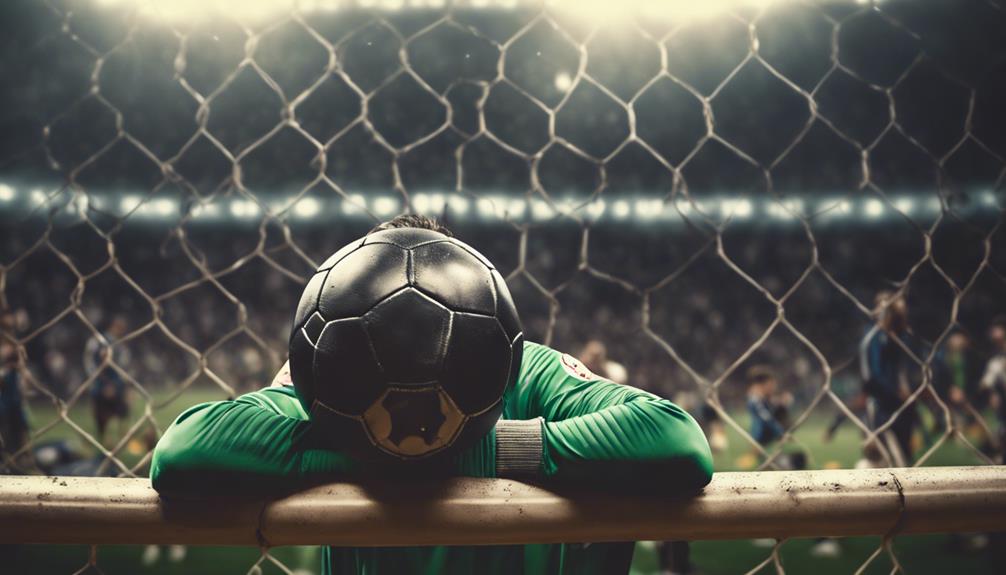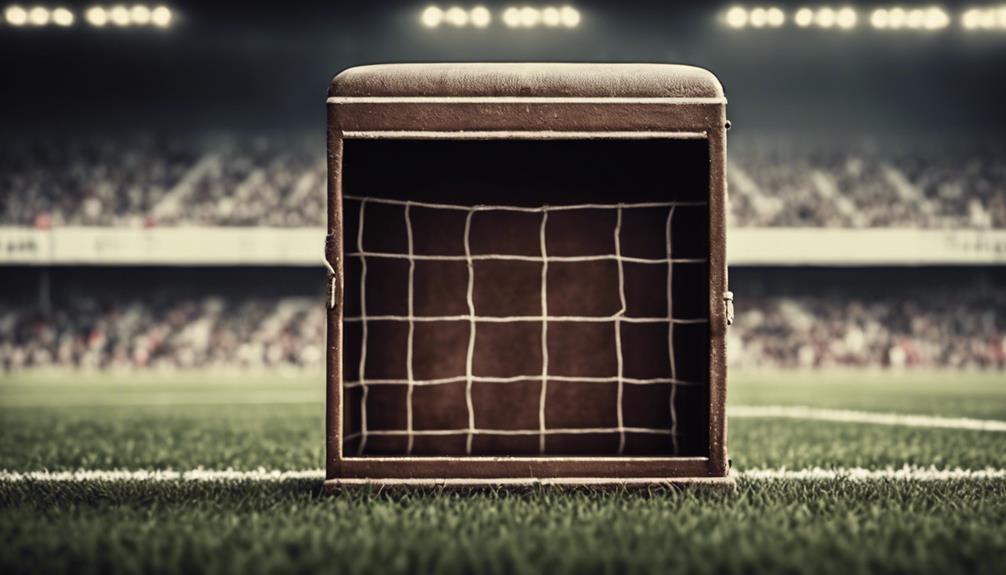
Understanding the Penalty Box in Soccer
August 6, 2024When you step into the penalty box in soccer, you enter a pivotal area where penalty kicks can decide the fate of the game. This small box, located right in front of the goal, is where high-stakes moments unfold, with only the kicker and the goalkeeper allowed inside during a penalty kick. Tactics like timing, deception, and varying approaches play a significant role in scoring or saving goals. By understanding the penalty box's rules and strategies, you can grasp the intricate dynamics that shape these intense moments on the field.
Penalty Kick Procedure
In the penalty kick procedure, the ball is placed on the penalty spot, 12 yards from the goal line. This spot is essential for kickers to aim for when taking a penalty kick. During this intense moment, only the kicker and the goalkeeper are allowed inside the penalty area. The referee initiates the kick with a whistle, signaling the kicker to make their move. Remember, the kicker can only touch the ball once until another player intervenes.
Infringements during penalty kicks are closely monitored. Actions such as encroachment, where players enter the penalty area before the kick, or feinting during the run-up can lead to various consequences. These can range from cautions to re-kicks or even indirect free kicks.
Pre-kick offenses like encroachment or other violations can result in disciplinary measures or the penalty kick being retaken. Therefore, it's essential for both the kicker and the defending team to adhere to the rules to guarantee a fair and just penalty kick.
Penalty Kick Tactics
When taking a penalty kick, consider using tap penalty techniques to catch the goalkeeper off guard.
Keep in mind that goalkeepers often rely on reading your body language to anticipate your shot direction.
Deception plays a vital role in executing successful penalty kick tactics.
Tap Penalty Techniques
To excel in tap penalty techniques during soccer matches, you must master the art of deceiving goalkeepers with subtle strikes. Tap penalties involve lightly tapping the ball, aiming to catch the goalkeeper off guard with unpredictable shots.
The success of tap penalties often lies in the timing of the kick, as a well-executed tap can be challenging for goalkeepers to anticipate. By using this technique, players can increase their success rates in penalty kicks.
When taking a tap penalty, your strategy should revolve around making the shot as unpredictable as possible. By varying your timing and approach, you can keep the goalkeeper guessing and increase your chances of scoring.
Goalkeepers pay close attention to your history of kicks to try and predict the direction of your tap penalty. By incorporating deceptive tactics into your tap penalty technique, you can outsmart the goalkeeper and improve your overall performance in penalty situations.
Goalkeeper's Reading Strategies
Analyzing the kicker's body language and tendencies is key for goalkeepers to predict the direction of penalty kicks effectively. Goalkeepers carefully observe the shooter's body language, foot placement, and eye focus to anticipate where the ball might be struck.
By studying the shooter's history of penalty kicks, goalkeepers can identify tendencies and preferred shooting techniques, aiding in decision-making during pivotal moments. Decisive goalkeepers often pre-determine their dive direction based on these visual cues and shooter tendencies, significantly improving their save chances.
Successful goalkeepers rely on mental focus to remain one step ahead of the kicker, enabling them to make split-second decisions and react swiftly to penalty kicks. Through a deep understanding of the kicker's habits and behaviors, goalkeepers enhance their chances of making crucial saves during penalty shootouts.
This strategic approach to reading the shooter's movements and tendencies is vital for goalkeepers looking to excel in saving penalty kicks.
Deception in Penalty Kicks
Deception plays an essential role in penalty kicks, utilizing tactics like the tap penalty technique to outsmart goalkeepers and increase scoring chances.
The element of surprise is critical during penalty kicks, as unexpected moves such as a quick tap or a delayed shot can catch goalkeepers off guard, leading to successful tap penalties.
A classic example of a successful tap penalty is Antonin Panenka's famous chip against Germany in the 1976 European Championship final.
Strategic deception in penalty kicks involves tricking the goalkeeper with sudden changes in shot direction or timing, ultimately increasing the likelihood of scoring.
Goalkeepers can improve their chances of saving penalty kicks by studying the kicker's history, including their preferred shot placement and tendencies.
Goalkeeper's Role and Distractions

During penalty kicks in soccer, the goalkeeper's ability to anticipate the shooter's movements is vital for making a successful save. Goalkeepers must rely on split-second decision-making to react to the kicker's shot placement accurately. Pre-deciding the dive direction based on the kicker's tendencies can enhance the goalkeeper's chances of saving a penalty.
Additionally, goalkeepers sometimes use distractions like subtle movements or eye contact to put pressure on penalty takers, increasing the likelihood of missed penalty kicks and creating save opportunities. By studying the shooter's history and staying focused during the critical moments leading up to the kick, goalkeepers can increase their chances of making a decisive save.
These distraction techniques, when executed effectively, can play a significant role in disrupting the shooter's concentration and leading to missed opportunities for the opposing team.
Statistics and Scoring
Scoring accuracy in penalty kicks serves as a pivotal metric in evaluating player performance and team success in soccer matches. Penalty kicks have an average success rate of 80% in professional soccer, with major leagues like the English Premier League seeing around 76% of penalty kicks finding the back of the net.
Goalkeepers manage to save approximately 18-20% of penalty kicks, although success rates can vary based on individual skill and strategy. Players who aim at the lower corners of the goal tend to have a higher chance of scoring from penalty kicks.
Utilizing the instep technique increases the likelihood of success, with about 70% of penalty kicks converted using this method. These statistics highlight the importance of scoring from penalty kicks, showcasing the impact it can have on overall team performance and match outcomes within the penalty box.
History of Penalty Kick Rules

You'll discover the early origins of penalty kicks and how they've evolved over time.
The controversies surrounding rule changes will be explored, shedding light on the debates within the soccer community.
Understanding the history of penalty kick rules provides insight into the development of fair play in the sport.
Early Penalty Kick Origins
The introduction of the penalty kick in 1891 marked a significant shift in how fouls within the goal area were penalized in early soccer history. Initially taken from 12 yards directly in front of the goal, penalty kicks aimed to provide a clear opportunity to score following a foul.
Feinting, a common tactic to deceive goalkeepers, was eventually banned in 1902 to ensure fair play during penalty kicks. As the game progressed, the rules surrounding penalty kicks evolved to address various issues and controversies that arose.
Historical records document crucial moments that shaped the development of penalty kick rules, reflecting the ongoing quest for justice and balance in the sport.
- Penalty kick introduced in 1891
- Taken from 12 yards in front of the goal
- Feinting common until banned in 1902
- Evolution of penalty kick rules over time
Evolution of Rules
The historical evolution of penalty kick rules in soccer showcases a continuous pursuit for fairness and integrity. Initially, indirect free kicks were awarded for fouls inside the box until the penalty kick rule was introduced in 1891, replacing the controversial 'combination kick' rule.
Over time, changes were made to enhance player fairness and safety. Feinting during penalty kicks was permitted until 1997 when IFAB banned it due to ethical concerns.
In 2019, the rule allowing goalkeepers to move laterally along the goal line during penalty kicks was introduced to balance the game's dynamics. These adjustments reflect a commitment to upholding the spirit of the game while prioritizing player safety.
IFAB's regular reviews and updates to penalty kick rules signify a dedication to ensuring that the rules adapt to the evolving nature of football, maintaining a level playing field for all involved.
Rule Change Controversies
Amidst the historical evolution of penalty kick rules in soccer, debates surrounding rule changes have ignited discussions within the soccer community.
The evolution of penalty kick regulations hasn't been without its share of contentious issues. Here are some key points to bear in mind:
- Rule adjustments to penalty kick regulations have sparked debates over the years.
- Disputes have emerged regarding feinting during penalty kicks and subsequent rule modifications.
- Expansion of offenses eligible for penalty kicks has been a point of contention.
- Various disputes surrounding penalty kicks have led to revisions in the Laws of the Game.
These disputes highlight the importance of continuously reassessing and refining the regulations governing penalty kicks to uphold the spirit of the game and ensure a level playing field for all teams.
Penalty Box Features
Nestled inside the penalty box in soccer is a smaller six-yard box known as the goal area. This area serves as an essential space for various key moments during a match.
Defending teams often utilize the penalty box for goal kicks and free kicks, providing them with an opportunity to clear the ball from their defensive third effectively.
The penalty spot, located 12 yards from the goal line at the center of the penalty area, is where penalty kicks are taken. During a penalty kick, only the goalkeeper and the kicker are allowed inside the penalty box, creating a tense one-on-one situation.
The goalkeeper's ability to anticipate the kicker's direction or strike plays a crucial role in their attempt to save the penalty. Understanding the dynamics of the penalty box, penalty area, and goal area enhances your grasp of strategic plays and defensive tactics employed by teams in pivotal moments of a soccer match.
Penalty Box and Corner Kicks

When preparing for corner kicks in soccer, teams strategically position players inside and outside the penalty box to maximize goal-scoring opportunities.
During corner kicks, players take the kick from the corner arc outside the penalty box, aiming to deliver accurate crosses into the penalty box for scoring chances.
Defending teams carefully position players inside and outside the penalty box to prevent the attacking team from scoring directly from the corner kick.
While the penalty box itself doesn't have a direct role in the execution of corner kicks, it serves as the area where most scoring opportunities are created.
Scoring directly from a corner kick is considered a rare but impressive feat in soccer, highlighting the skill and precision required to execute such plays effectively.
Importance of Penalty Area
Teams in soccer rely heavily on the penalty area for key aspects of the game, such as penalty kicks and goal-scoring opportunities. The penalty area, often referred to as the 18-yard box, is a vital zone on the field where goalkeepers have special privileges, like handling the ball with their hands.
This area is where defending teams must employ specific strategies to protect their goal during set pieces and opponent attacks. The penalty spot, situated 12 yards from the goal line, is a focal point inside the penalty area for taking penalty kicks, presenting both a challenge for the shooter and an opportunity for the goalkeeper.
Understanding the dynamics of the penalty area is essential for teams to devise effective defensive strategies and capitalize on goal-scoring chances. Research emphasizes the importance of the penalty area in shaping goal-scoring patterns and defensive tactics in soccer matches, making it a pivotal area that can determine the outcome of games.
Conclusion
So there you have it, the penalty box in soccer is like a mysterious domain where players face the ultimate test of skill and nerve.
With goalkeepers trying to psych you out and statistics looming over your every move, it's like stepping into a high-stakes game of chess.
But hey, at least you'll always have the satisfaction of knowing that you gave it your all, even if you end up missing the mark.


